
|
THE OPENING is all about introducing the fascinating, quirky and wonderful people working in and around the visual arts in Vancouver. Each week, we'll feature an artist, collective, curator or administrator to delve deep into who and what makes art happen! |
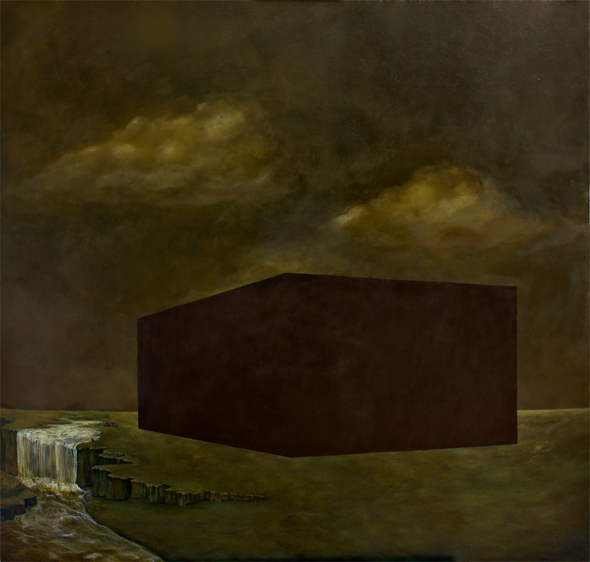
Detail of 'Displacement' from 'Like A Great Black Fire'
How do you distinguish a good mystery from a bad one? A bad one is obvious from the beginning – contrived, with clues everywhere and little respect for the intelligence of the audience. A good mystery keeps changing the game – clues lead to what you thought was the solution but what was really only a piece of a complex but in the end, somehow obvious puzzle. Even better is the mystery that remains mostly unsolved, forcing the audience to keep thinking about it long after the book or movie or performance has ended, to keep theorizing and imagine their own ending. Painter Rebecca Chaperon (b. 1978) is all about the dark and mysterious, and especially open endings and visuals that leave everything to your imagination.
Chaperon grew up in England, moving to Canada with her family when she was 8. She counts this early English life as an influence on her vision, but more so her voracious consumption of literature. She grew up reading the classics, and “a lot of that stuff is pretty dark,” as she notes. “There are always hard lessons to be told.” In particular she was “obsessed” with Thomas Hardy’s novels. Both a novelist and poet, Hardy was known for novels like Tess of the d’Urbervilles, often exploring and critiquing the Victorian social order and its suppression of happiness. Also influenced by horror movies and writer Margaret Atwood, Chaperon is quick to note that she has never “set out to emulate any of those themes or tones, but eventually it all filters in and mixes with my own feeling of how I want to portray something.”
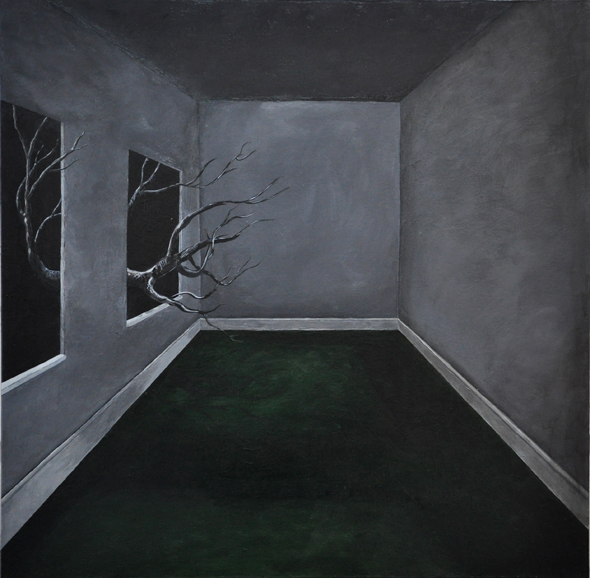
'Silence' 2010
Before her most recent series of paintings Like A Great Black Fire (which will be discussed shortly), Chaperon worked in a smaller size and scale, exploring the line between mystery and the point at which it is resolved. When the solution of a mystery is revealed, “it’s boring,” she says. “It’s kind of nice to have that mysterious thing that makes you feel small and insignificant. Never reveal the end.” Works like Silence recall the creepy poetry of Edgar Allan Poe. Somehow she has managed to visualize the wind whistling through the barren room, accented by the branches whipping against the window frame. This ability to draw out a mood is rare, and Chaperon is clearly good at it. She often uses a young female figure to create these emotional tones and give them a human touch. In Catholic Schoolgirls Rule, she took old book covers, cut them to fit ornate gold frames salvaged from across the city, and painted one schoolgirl or many across the book. These floating figures with their Medusa-like hair both sink into the books and pop out all at once. You can almost imagine them floating and flipping through the pages as the narrative speaks of them.
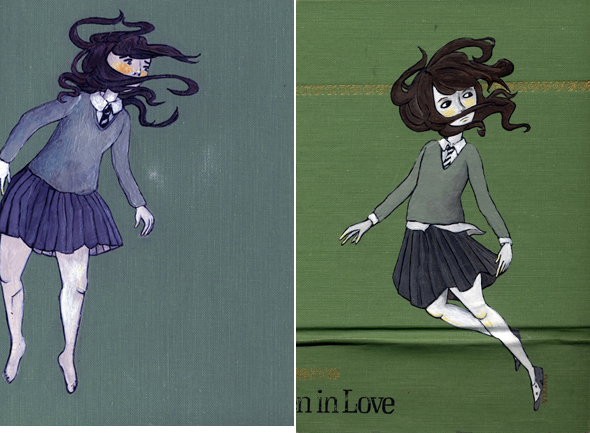
'Catholic Schoolgirls Rule'
Back to Like A Great Black Fire, her most recent series of paintings showing at Grunt Gallery this Fall. Grunt accepts proposals for exhibitions, and Chaperon put everything on hold to write the proposal that resulted in this body of work. She took several months to put it all together and think about what she wanted to focus on, and feels it is very important for an artist to do that every once in a while - to stop producing something for relatively the same every month and instead take “the time to let ideas shift and change and then change the work.” Though it was hard for her to say no to all those little group exhibit offers, the end result is definitely a stronger step forward for her painting.
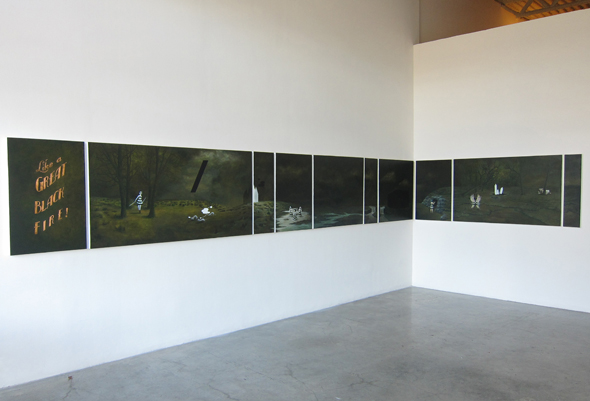
'Like A Great Black Fire' installed at Grunt Gallery (Photo courtesy Grunt Gallery)
Chaperon knew from the beginning that she wanted to create a narrative with this series, and it is difficult to really understand how she has done that by looking at any single work from the series without all the others. The installation is important as it is clear they each lead into the other - the viewer can either read the entire installation as one moment in time; or in a linear manner with the action in each canvas occurring after the one previous. If considered as a linear narrative, it is clear the female figurines undergo a transition, from youthfully masked to shrouded in what looks like flames. Is it a sign of maturity? Perhaps. They certainly seem more conscious of their appearance, and perhaps out of fear of revealing too much hide from their audience and give away little that would truly tell us who they are and how they got here, creating both a physical and narrative mystery that we are left to ponder without answer. If Chaperon keeps taking the time to draw these mysteries out of her imagination and onto the canvas, we have a lot more to look forward to.
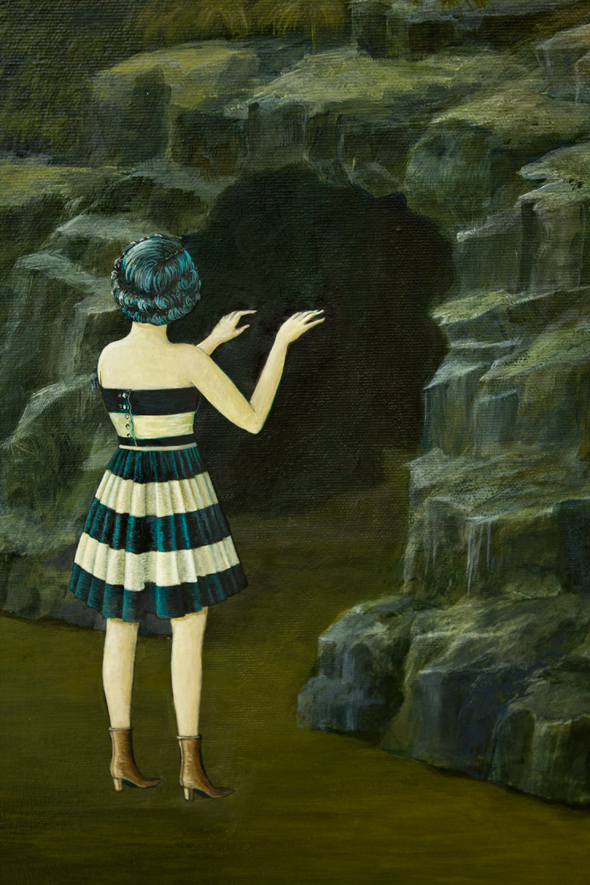
Detail from 'Like a Great Black Fire'
Rebecca Chaperon lives and works in Vancouver. She has previously exhibited in Vancouver at Little Mountain Gallery, Ayden Gallery, Performance Works, Winsor Gallery, Gallery Atsui, Grace Gallery, Access, and Helen Pitt Gallery. Her new series ‘Like A Great Black Fire’ can be seen at Grunt Gallery from September 8 - October 15, 2011. For more information, please visit her website at thechaperon.ca.
All images courtesy Rebecca Chaperon unless otherwise noted.


